 |
| |
Sons of Confederate Veterans,
Camp #16
Confederate Flag History
| |
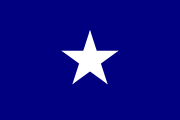 |
The Bonnie
Blue
The Bonnie Blue Flag, a single white star on a blue field,
was the flag of the short-lived Republic of West Florida. It
was created by Melissa Johnson, sister-in-law of Major Isaac
Johnson, commander of the West Florida Dragoons. In September
1810, settlers in the Spanish territory of West Florida revolted
against the Spanish government and proclaimed an independent
republic. The Bonnie Blue Flag was raised at the Spanish fort
in Baton Rouge on September 23, 1810. On December 6, 1810,
West Florida was annexed by the United States and the republic
ceased to exist, after a life of 74 days.
When Mississippi seceded from the Union on January
9, 1861, as a sign of independence, the
Bonnie Blue Flag was raised over the capitol building
in Jackson. On January
26, 1861,
In addition to the national flags, a wide variety of flags
and banners were flown by Southerners during the War. Most
famously, the "Bonnie Blue Flag" was used as an
unofficial flag during the early months of 1861. It was flying
above the Confederate batteries that first opened fire on
Fort Sumter. |
| |
|
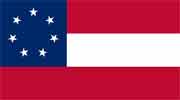
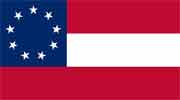
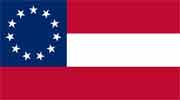
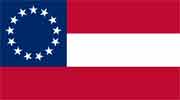
|
The
First National, The Stars and Bars
March 5, 1861 - May 1, 1863
The first
official flag of the Confederacy, called the "Stars and Bars," was
flown from March 5, 1861, to May 26, 1863.
The very first national flag of the Confederacy
was designed by Prussian artist Nicola Marschall in Marion,
Alabama. The Stars and Bars flag was adopted March
4, 1861 in Montgomery, Alabama
and raised over the dome of that first Confederate Capitol.
Marschall also designed the Confederate uniform.
One of the
first acts of the Provisional Confederate Congress was
to create the Committee on the Flag and Seal, chaired by
William Porcher Miles of South Carolina. The committee
asked the public to submit thoughts and ideas on the topic
and was, as historian John M. Coski puts it, "overwhelmed
by requests not to abandon the 'old flag' of the United States." Miles
had already designed a flag that would later become the Confederate
battle flag, and he favored his flag over the "Stars
and Bars" proposal. But given the popular support for
a flag similar to the U.S. flag ("the Stars and Stripes"),
the Stars and Bars design was approved by the committee.
When war broke out, the Stars and Bars caused confusion on
the battlefield because of its similarity to the U.S. flag
of the U.S. Army.
Eventually, a total of thirteen stars would
be shown on the flag, reflecting the Confederacy's claims
to have admitted Kentucky and Missouri into their union.
The first public appearance of the 13-star flag was outside
the Ben Johnson House in Bardstown, Kentucky. The 13-star
design was also used as the basis of a naval ensign. |
| |
|
 |
The Second
National - March 1,1863
During the solicitation
for the second national flag, there were many different
types of designs that were proposed, nearly all making
use of the battle flag, which by 1863 had become well-known
and popular. The new design was specified by the Confederate
Congress to be a white field "with
the union (now used as the battle flag) to be a square of
two-thirds the width of the flag, having the ground red;
thereupon a broad saltier [sic] of blue, bordered with white,
and emblazoned with mullets or five-pointed stars, corresponding
in number to that of the Confederate States."
The nickname "stainless" referred
to the pure white field. The flag act of 1864 did not state
what the white symbolized and advocates offered various
interpretations. The most common interpretation is that
the white field symbolized the purity of the Cause. The
Confederate Congress debated whether the white field should
have a blue stripe and whether it should be bordered in
red. William Miles delivered a speech for the simple white
design that was eventually approved. He argued that the
battle flag must be used, but for a national flag it was
necessary to emblazon it, but as simply as possible, with
a plain white field.
The flags actually made by the Richmond Clothing
Depot used the 1.5:1 ratio adopted for the Confederate Navy's
battle ensign, rather than the official 2:1 ratio.
Initial reaction to the second national
flag was favorable, but over time it became criticized
for being "too white".
The Columbia Daily South Carolinian observed that
it was essentially a battle flag upon a flag of truce and
might send a mixed message. Military officers voiced complaints
about the flag being too white, for various reasons, including
the danger of being mistaken as a flag
of truce, especially on naval ships, and that it was
too easily soiled. This
flag is nonetheless a historical symbol of the civil war. |
| |
|
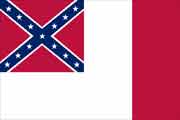 |
Third
National Flag ("the Blood Stained Banner")
(Since 4 Mar 1865)
The third national flag was adopted March 4, 1865, just
before the fall of the Confederacy. The red vertical stripe
was proposed by Major Arthur L. Rogers, who argued that the
pure white field of the second national flag could be mistaken
as a flag of truce. When hanging limp in no wind, the flag's Southern
Cross canton could accidentally stay hidden, so the
flag could mistakenly appear all white.
Rogers lobbied successfully to have this
alteraton introduced in the Confederate Senate. He defended
his redesign as having "as
little as possible of the Yankee blue", and described
it as symbolizing the primary origins of the people of the
South, with the cross of Britain and the red bar from the
flag of France.
The Flag Act of 1865 describes the flag
in the following language: "The Congress of the Confederate
States of America do enact, That the flag of the Confederate
States shall be as follows: The width two-thirds of its
length, with the union (now used as the battle flag) to
be in width three-fifths of the width of the flag, and
so proportioned as to leave the length of the field on
the side of the union twice the width of the field below
it; to have the ground red and a broad blue saltire thereon,
bordered with white and emblazoned with five pointed stars,
corresponding in number to that of the Confederate States;
the field to be white, except the outer half from the union
to be a red bar extending the width of the flag." |
| |
|
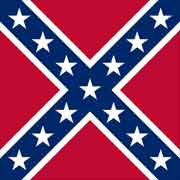 |
The Battle Flag
Often referred to as "The" battle flag of the
Confederacy it was the design that was the basis of more
than 180 separate Confederate military battle flags.
The Army
of Northern Virginia battle flag was usually square,
of various sizes for the different branches of the service:
48 inches square for the infantry, 36 inches for the artillery,
and 30 inches for the cavalry. It was used in battle beginning
in December 1861 until the fall of the Confederacy. The
blue color on the saltire in the battle flag was navy blue,
as opposed to the much lighter blue of the Naval Jack.
The flag's stars represented the number of states in the
Confederacy. The distance between the stars decreased as
the number of states increased, reaching thirteen when the
secessionist factions of Missouri and Kentucky joined
in late 1861.
At the First
Battle of Manassas, the similarity between the Stars
and Bars and the Stars and Stripes caused confusion and
military problems. Regiments carried flags to help commanders
observe and assess battles in the warfare of the era. At
a distance, the two national flags were hard to tell apart.
In addition, Confederate regiments carried many other flags,
which added to the possibility of confusion. After the
battle, General P.G.T.
Beauregard wrote that he was "resolved then to
have [our flag] changed if possible, or to adopt for my
command a 'Battle flag', which would be Entirely different
from any State or Federal flag."He
turned to his aide, who happened to be William Porcher
Miles, the former chair of Committee on the Flag and Seal.
Miles described his rejected national flag design to Beauregard.
Miles also told the Committee on the Flag and Seal about
the general's complaints and request for the national flag
to be changed. The committee rejected this idea by a four
to one vote, after which Beauregard proposed the idea of
having two flags. He described the idea in a letter to
his commander General Joseph
E. Johnston: "I wrote to [Miles] that we should
have two flags — a peace or parade flag,
and a war flag to be used only on the field of
battle — but congress having adjourned no action will be
taken on the matter — How would it do us to address the
War Dept. on the subject of Regimental or badge flags made
of red with two blue bars crossing each other diagonally
on which shall be introduced the stars, ... We would then
on the field of battle know our friends from our Enemies."
The flag that Miles had favored when
he was chair of the Committee on the Flag and Seal
eventually became the battle flag and, ultimately,
the most popular flag of the Confederacy. According
to historian John Coski, Miles' design was inspired
by one of the many "secessionist
flags" flown
at the South Carolina secession convention of December,
1860. That flag was a blue St
George's Cross (an upright or Latin cross) on a red field,
with 15 white stars on the cross, representing the slave
states, and, on the red field, palmetto and crescent
symbols. Miles received a variety of feedback on this design,
including a critique from Charles Moise, a self-described "Southerner
of Jewish persuasion". Moise liked the design, but asked
that "the symbol of a particular religion not be made
the symbol of the nation." Taking this into account,
Miles changed his flag, removing the palmetto and crescent,
and substituting a heraldic saltire ("X") for the
upright one. The number of stars was changed several times
as well. He described these changes and his reasons for making
them in early 1861. The diagonal cross was preferable, he
wrote, because "it avoided the religious objection about
the cross (from the Jews and many Protestant sects), because
it did not stand out so conspicuously as if the cross had
been placed upright thus." He also argued that the diagonal
cross was "more Heraldric [sic] than Ecclesiastical,
it being the 'saltire' of Heraldry, and significant
of strength and progress."
Although Miles described his flag as a heraldic saltire,
it had been thought to be erroneously described since the
latter part of the 19th century as a cross, specifically
a Saint
Andrew's Cross. Supposedly this folk legend sprang from
the memoirs of an aging Confederate officer published in
1893. However, further research has indicated that this was
no folk legend. In 1863, during the session in which the
Confederate Congress was voting on the 2nd National Flag,
William G. Swan of Tennessee's second congressional district
wished to substitute the following language:
"That the flag of the Confederate States shall be
as follows:
A red field with a Saint Andrew's cross of blue edged with
white and emblazoned with stars."
|
| |
|
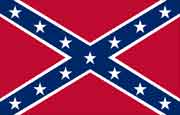 |
The Confederate Battle Flag
What is now often called "The Confederate
Flag" or "The Confederate Battle Flag" (actually
a combination of the battle flag's colors with the second
naval jack design), despite its never having historically
represented the CSA as a nation, has become a widely recognized
symbol of the
South. It is also called the "rebel", "Southern
Cross, or "Dixie" flag,
and is often incorrectly referred to as the "Stars and
Bars" (the actual "Stars and Bars" is the
First National Flag, which used an entirely different design).
During the first half of the 20th century the
Confederate flag enjoyed renewed popularity. During World
War II some U.S. military units with Southern nicknames,
or made up largely of Southerners, made the flag their unofficial
emblem. The USS
Columbia (CL-56) flew a Confederate Navy Ensign as a
battle flag throughout combat in the South Pacific in World
War II. This was done in honor of the ship's namesake, the
capital city of South Carolina, the first state to secede
from the Union. Some soldiers carried Confederate flags into
battle. After the Battle
of Okinawa a Confederate flag was raised over Shuri
Castle by a Marine from the self-styled "Rebel Company" (Company
A of the 1st
Battalion, 5th Marines). It was visible for miles and
was taken down after three days on the orders of General
Simon B. Buckner, Jr. (son of Confederate General Simon
Buckner), who stated that it was inappropriate as "Americans
from all over are involved in this battle". It was replaced
with the flag of the United States. |
| |
|
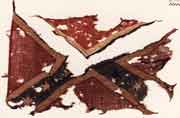
All rights reserved AlabamaDepartment
of Archives & History
|
The Original 5oth Alabama
Infantry Battle Flag
Provenance Reconstruction:
Organized in March 1862, this regiment was originally designated
as the 26th Alabama Infantry. This designation was later
changed to the 50th Alabama Infantry. The date that this
flag was issued is unknown, however, its use will post date
December 1863 when Joseph E. Johnston assumed command of
the Army of Tennessee. Johnston had new battle flags of this
pattern issued in the early spring, 1864.
Following the war, former Lt. Colonel
Newton Nash Clements apparently retained possession of
the flag. Dr. Thomas Owen, Director, Alabama Department
of Archives and History, began writing Mrs. N. N. Clements
concerning the flag on October 22, 1904. Over the years,
he continued to request the donation of the flag which
was finally forwarded to the Department on August 7, 1909.
The flag was donated by Mrs. Clements and her daughter
Miss Belle Cements. The accession log entry of August 12,
1909 describes the flag as "badly mutilated". |
| |
|
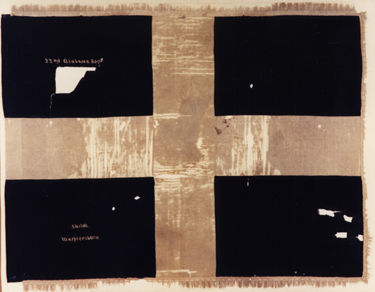
22ND ALABAMA INFANTRY REGIMENT - ALABAMA
DEPARTMENT OF ARCHIVES AND HISTORY , MONTGOMERY, ALABAMA.
|
22ND ALABAMA INFANTRY REGIMENT - ALABAMA |
| |
|
|
|
|



